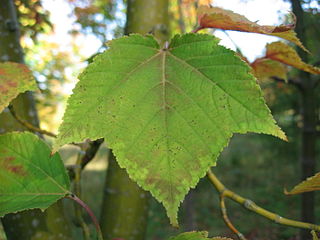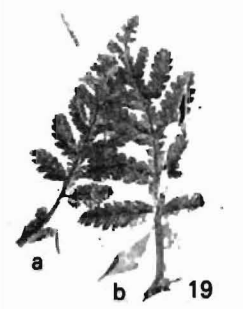
Peltandra, the arrow arums, is a genus of plants in the family Araceae. It is native to the eastern United States, eastern Canada, and Cuba.
- Peltandra sagittifolia - (Michx.) Morong - Spoon flower or the white arrow arum - southeastern US from eastern Louisiana to Virginia
- Peltandra virginica(L.) Schott - Arum arrow - Cuba, Quebec, Ontario, Oregon, California, Washington; eastern US from Maine to Florida, west to Texas, Kansas, and Minnesota
- †Peltandra primaeva – Eocene, Golden Valley Formation, North Dakota, USA

Florissantia is an extinct genus of flowering plants in the Malvaceae subfamily Sterculioideae known from western North America and far eastern Asia. Flower, fruit, and pollen compression fossils have been found in formations ranging between the Early Eocene through to the Early Oligocene periods. The type species is Florissantia speirii and three additional species are known, Florissantia ashwillii, Florissantia quilchenensis, and Florissantia sikhote-alinensis.
Pinus peregrinus is an extinct species of pine in the family Pinaceae known from Clarkforkian age Paleocene fossils found in western North Dakota, USA.
Petrocardium is an extinct genus of monocot plants in the family Araceae. At present it contains only two species Petrocardium cerrejonense and Petrocardium wayuuorum, the type species. The genus is solely known from the Middle to Late Paleocene, Cerrejón Formation deposits in Colombia.
Montrichardia aquatica is an extinct species of monocot plant in the family Araceae. M. aquatica is related to the living species M. arborescens and M. linifera. The species is solely known from the Middle to Late Paleocene, fossil-rich Cerrejón Formation in La Guajira, northern Colombia.
Acer douglasense is an extinct maple species in the family Sapindaceae described from fossil leaves. The species is solely known from the Early Eocene sediments exposed in Katmai National Park and Preserve, Kodiak Island Borough, Alaska. It is the type species for the extinct section Douglasa.
Acer alaskense is an extinct maple species in the family Sapindaceae described from a fossil leaf. The species is solely known from the Latest Paleocene sediments exposed in the Matanuska River Valley, Matanuska-Susitna Borough, Alaska. It is the type species for the extinct section Alaskana.
Acer toradense is an extinct maple species in the family Sapindaceae described from two fossil samaras. The species is solely known from the Early Eocene sediments exposed in northeast Washington state, United States, and the adjacent area of south central British Columbia, Canada. It is one of three species belonging to the extinct section Torada.
Acer washingtonense is an extinct maple species in the family Sapindaceae described from one fossil leaf and four fossil samaras. The species is solely known from the Early Eocene sediments exposed in northeast Washington state, United States. It is one of three species belonging to the extinct section Torada.
Acer stewarti is an extinct maple species in the family Sapindaceae described from a series of fossil leaves and samaras. The species is solely known from the Early Eocene sediments exposed in south central British Columbia, Canada adjacent to northeast Washington state, United States. It is one of only two species belonging to the extinct section Stewarta.
Acer browni is an extinct maple species in the family Sapindaceae described from a series of isolated fossil leaves and samaras. The species is known from the early to middle Miocene sediments exposed in Western Oregon, Washington state, USA and Northern Graham Island, Haida Gwaii, Canada. It is one of several extinct species placed in the living section Parviflora.
Acer ashwilli is an extinct maple species in the family Sapindaceae described from a group of fossil leaves and samaras. The species is solely known from the Early Oligocene sediments exposed in central Oregon, USA. It is one of several extinct species belonging to the living section Ginnala.
Acer dettermani is an extinct maple species in the family Sapindaceae described from a series of isolated fossil leaves. The species is known from the late Eocene to early Oligocene sediments exposed in the state of Alaska, USA. It is one of several extinct species placed in the living section Macrantha.

Acer latahense is an extinct maple species in the family Sapindaceae described from series of isolated fossil leaves. The species is known from the latest early to middle Miocene sediments exposed in the states of Oregon and Washington, USA. It is one of several extinct species placed in the living section Macrantha.

Orontium wolfei is an extinct golden-club species in the family Araceae described from a series of isolated fossil leaves. The species is known from Eocene sediments exposed in the state of Washington in the United States of America and the province of British Columbia in Canada. It is one of several extinct species placed in the living golden-club genus Orontium.
Orontium mackii is an extinct golden club species in the family Araceae described from a series of isolated fossil leaves. The species is known from Late Cretaceous sediments exposed in the state of New Mexico in the United States of America. It is one of several extinct species placed in the living golden-club genus Orontium.

Stonebergia is an extinct genus in the rose family, Rosaceae, which contains the single species Stonebergia columbiana. The genus was described from a series of isolated fossil leaves in shale from an early Eocene location in southern British Columbia.
The Golden Valley Formation is a stratigraphic unit of Late Paleocene to Early Eocene age in the Williston Basin of North Dakota. It is present in western North Dakota and was named for the city of Golden Valley by W.E. Benson and W.M. Laird in 1947. It preserves significant assemblages of fossil plants and vertebrates, as well as mollusk and insect fossils.

Barghoornia is an extinct genus of flowering plants in the family Burseraceae containing the solitary species Barghoornia oblongifolia. The species is known from fossil leaves found in the early Eocene deposits of northern Washington state, United States.





